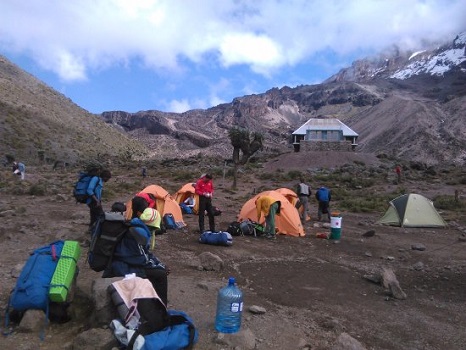Climbing Mount Kilimanjaro is a dream for many adventure seekers — and the good news? You don’t need to be an expert mountaineer to reach the summit! Kilimanjaro is one of the few high-altitude mountains in the world that you can hike to the top without technical climbing experience. If you're new to trekking or mountain expeditions, this guide is for you.
🧭 What Makes Kilimanjaro Beginner-Friendly?
- No ropes or technical climbing needed
- Well-established routes with guides and porters
- Trekking, not mountaineering – it's a long hike, not a vertical climb
- Multiple route options suited to various fitness levels
- Experienced guides lead you every step of the way
🏔️ Top Beginner-Friendly Kilimanjaro Routes
1. Marangu Route (5–6 Days)
Known as the "Coca-Cola Route". It’s the only route with hut accommodations. Gentle gradients but shorter acclimatization window makes it more risky for altitude sickness.
2. Machame Route (6–7 Days)
Popular and scenic "Whiskey Route", slightly more demanding but with better acclimatization.
3. Lemosho Route (7–8 Days)
Highly recommended for beginners due to gradual ascent and great scenery. Offers better success rates.
4. Northern Circuit (8–9 Days)
Longest route with the best acclimatization and highest summit success rate. Also one of the quietest trails.
🧱 Minimum Requirements to Climb Kilimanjaro
- Age: 10 years and older
- Fitness: Good physical health, able to hike for 5–8 hours a day
- No technical experience required
- Mental strength and preparation
🧗 How to Prepare as a Beginner
🥾 1. Physical Training
- Start training 2–3 months in advance
- Focus on cardio, hiking, stair climbing
- Include endurance and leg strength workouts
🧘 2. Altitude Acclimatization
Choose a longer route to allow your body to adapt. Consider pre-acclimatization hikes or altitude simulation masks.
🎒 3. Get the Right Gear
- Layered clothing (base, mid, outer layers)
- Broken-in hiking boots
- Sleeping bag rated to -10°C or colder
- Daypack, trekking poles, gloves, headlamp
🧪 4. Medical Prep
- Consult a doctor before the trip
- Consider altitude meds like Diamox
- Bring a basic medical kit
🩺 What About Altitude Sickness?
Altitude sickness (AMS) is the main challenge on Kilimanjaro. Symptoms include headache, fatigue, and nausea. Avoid rushing, hydrate well, and choose a route with good acclimatization days. Guides monitor you for symptoms and carry oxygen and first aid.
🧳 What’s Included in a Beginner Trek Package?
- Park fees and permits
- Professional guides, porters, and cook
- Tents or huts (Marangu)
- All meals and drinking water
- Emergency oxygen and first aid
- Transfers and hotel stays (depending on package)
💡 Tips for First-Time Climbers
- Go slow – “Pole pole” (slowly, slowly) is key
- Drink 3–4 liters of water daily
- Get used to your gear before the trek
- Rest and listen to your body
- Choose a longer route if unsure
🏆 Final Thoughts – Yes, You Can Climb Kilimanjaro!
If you're relatively fit, mentally prepared, and choose the right route and team — you absolutely can reach the summit of Africa’s highest peak. Thousands of first-time trekkers reach Uhuru Peak every year. Kilimanjaro is calling!
✅ Frequently Asked Questions (FAQs)
1. Can a beginner really climb Kilimanjaro?
Yes! You don’t need any prior climbing or mountaineering experience. Many beginners reach the summit each year with proper guidance and preparation.
2. How fit do I need to be?
You should be able to hike for several hours a day. Cardiovascular endurance, mental strength, and strong legs help, but elite fitness is not required.
3. Which route is best for beginners?
Lemosho and Northern Circuit are the best for acclimatization. Machame is scenic and doable for fit beginners. Marangu is easy terrain-wise but has a lower success rate.
4. What is altitude sickness and should I be worried?
It’s your body reacting to low oxygen at high altitude. Symptoms include headache, nausea, and fatigue. Choosing longer routes and listening to your guide helps minimize the risk.
5. What’s the success rate for beginners?
With proper preparation and a longer route, the success rate is 85–95%. The Northern Circuit and Lemosho have the highest success rates.
6. What kind of gear do I need?
You’ll need warm clothing, waterproof outerwear, a quality sleeping bag, hiking boots, and accessories like gloves, hat, and trekking poles. Most operators provide rentals too.
7. Do I need a guide or can I go solo?
Kilimanjaro is a protected national park. All climbers are required to hire a licensed guide and be part of a registered trekking group.
8. When is the best time to climb Kilimanjaro?
The best months are January to March and June to October. Avoid the rainy seasons (April–May and November) for safer and more enjoyable trekking.
9. Will I need vaccinations or a visa?
Yes, a tourist visa for Tanzania is required. Vaccinations such as yellow fever (if transiting through affected areas), hepatitis A, typhoid, and tetanus are recommended.
10. How much does it cost to climb Kilimanjaro?
Expect to pay between $1,800 and $3,500 depending on the route, length, and operator quality. Make sure your tour includes proper gear, meals, and experienced staff.
